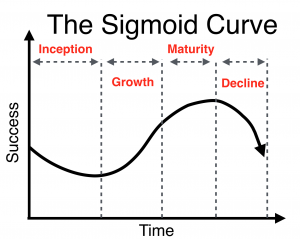Change is hard at first, messy in the middle, and gorgeous at the end.
~Robin Sharma
One of the things I love about working in schools is the cyclical nature of the school year. At the beginning of each school year, staff has the opportunity to dig into great work and build lasting relationships with a new group of students. The beginning of each year brings change. While some are excited by the idea of change, some are exhausted or stressed by the change, and for good reason.
Just as the school year follows a cycle, the change process also follows a predictable rhythm. This rhythm is best described by the Sigmoid Curve or S-Curve (see above) as it is commonly called. The S-Curve was applied to organizational change in the 1970s by by author and philosopher Charles Handy. Basically, the theory of the S-Curve states that when a new change is implemented, those charged with the heavy lifting undergo a period of chaos as they grapple with the new reality. It is often in the early stages of a change that we question why the change was made and wonder if life wasn’t better prior to the change. Often we consider throwing out the new way of doing things and going back to “the old way”. After a period of time, we enter the growth phase, when positive effects begin to take hold. At this time, those implementing the change begin to truly understand why the change was made. The third phase is called maturity. At this point, the change has taken hold in the organization and is simply the status quo. It is at this point that we hit a comfortable plateau and enter into the flow stage. Finally, the change may enter the decline phase. After a period of time, we find that new discoveries or forces have made our once-great change now obsolete, and we scramble to contend with our new reality.
Over the course of the year in Pleasantdale, we have experienced several changes and are in a variety of stages within the S-Curve. Most recently, we have implemented a new lunch program, began experimenting with new technologies in the classroom, rolled out a learning management system (Schoology), and made changes to our library program. All of these improvements are currently in the implementation phase, and it makes sense that we are questioning these changes. It is in this critical phase that we may have the urge to restore balance by ditching the new way and reverting back to the old. We need to resist that urge. Just as the quote at the top of this page suggests and years of research supports, we need to get through the initial messiness of the change to realize the wonderful benefits.
As a leader in our organization, it is my job to provide our staff, students, and families with the resources, training, and support they need to implement these changes with integrity. Over the course of the last year (we’ll call it the “pre-implementation phase”) we have created a professional development plan to support our staff and brought forth trainings for parents. Likewise, we fully understand the messiness that goes along with any change and know that our teachers are still learning the ropes when it comes to using these new tools. One of the most important things that school leaders can do is to listen to the feedback from staff and parents. If there are ways we can ease the stress of the new changes or provide additional support, we need to respond positively. Additionally, we need to celebrate the small victories and build upon them until we hit the growth phase.
Mark Twain famously said, “The only person who likes change is a baby with a wet diaper.” This is true in the initial phases of a change; however, the improvements we are bringing forth will create a better school experience for our students and families and a better work experience for our staff.

I applaud all the work that has been done to lay the groundwork for change and to get us from good to great! Thank you for leading the way and showing us what is possible.
Thank you, Kim! These are exciting changes; however, we need to be mindful of the change process and support our staff, parents, and students as we strive to make Pleasantdale the BEST district it can be! The future it bright for Pdale!